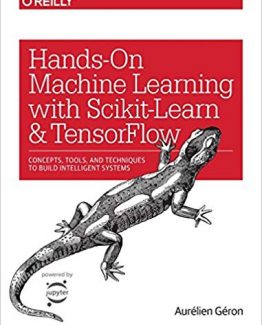Introduction to Cryptography with Coding Theory 3rd Edition by Wade Trappe, ISBN-13: 978-0134859064
[PDF eBook eTextbook]
- Publisher: Pearson; 3rd edition (September 18, 2020)
- Language: English
- ISBN-10: 0134859065
- ISBN-13: 978-0134859064
For courses in Cryptography, Network Security, and Computer Security.
A broad spectrum of cryptography topics, covered from a mathematical point of view.
Extensively revised and updated, the 3rd Edition of Introduction to Cryptography with Coding Theory mixes applied and theoretical aspects to build a solid foundation in cryptography and security. The authors’ lively, conversational tone and practical focus inform a broad coverage of topics from a mathematical point of view, and reflect the most recent trends in the rapidly changing field of cryptography.
Key to the new edition was transforming from a primarily print-based resource to a digital learning tool.
Table of Contents:
Brief Table of Contents Overview of Cryptography and Its Applications 1.1 Secure Communications 1.2 Cryptographic Applications Classical Cryptosystems 2.1 Shift Ciphers 2.2 Affine Ciphers 2.3 The VigenÈre Cipher 2.4 Substitution Ciphers 2.5 Sherlock Holmes 2.6 The Playfair and ADFGX Ciphers 2.7 Enigma 2.8 Exercises 2.9 Computer Problems Basic Number Theory 3.1 Basic Notions 3.2 The Extended Euclidean Algorithm 3.3 Congruences 3.4 The Chinese Remainder Theorem 3.5 Modular Exponentiation 3.6 Fermat and Euler 3.7 Primitive Roots 3.8 Inverting Matrices Mod n 3.9 Square Roots Mod n 3.10 Legendre and Jacobi Symbols 3.11 Finite Fields 3.12 Continued Fractions 3.13 Exercises 3.14 Computer Problems The One-Time Pad 4.1 Binary Numbers and ASCII 4.2 One-Time Pads 4.3 Multiple Use of a One-Time Pad 4.4 Perfect Secrecy of the One-Time Pad 4.5 Indistinguishability and Security 4.6 Exercises Stream Ciphers 5.1 Pseudo-Random Bit Generation 5.2 LFSR Sequences 5.3 RC4 5.4 Exercises 5.5 Computer Problems Block Ciphers 6.1 Block Ciphers 6.2 Hill Ciphers 6.3 Modes of Operation 6.4 Multiple Encryption 6.5 Meet-in-the-Middle Attacks 6.6 Exercises 6.7 Computer Problems The Data Encryption Standard 7.1 Introduction 7.2 A Simplified DES-Type Algorithm 7.3 Differential Cryptanalysis 7.4 DES 7.5 Breaking DES 7.6 Password Security 7.7 Exercises 7.8 Computer Problems The Advanced Encryption Standard: Rijndael 8.1 The Basic Algorithm 8.2 The Layers 8.3 Decryption 8.4 Design Considerations 8.5 Exercises The RSA Algorithm 9.1 The RSA Algorithm 9.2 Attacks on RSA 9.3 Primality Testing 9.4 Factoring 9.5 The RSA Challenge 9.6 An Application to Treaty Verification 9.7 The Public Key Concept 9.8 Exercises 9.9 Computer Problems Discrete Logarithms 10.1 Discrete Logarithms 10.2 Computing Discrete Logs 10.3 Bit Commitment 10.4 Diffie-Hellman Key Exchange 10.5 The ElGamal Public Key Cryptosystem 10.6 Exercises 10.7 Computer Problems Hash Functions 11.1 Hash Functions 11.2 Simple Hash Examples 11.3 The Merkle-Damg ̊ard Construction 11.4 SHA-2 11.5 SHA-3/Keccak 11.6 Exercises Hash Functions: Attacks and Applications 12.1 Birthday Attacks 12.2 Multicollisions 12.3 The Random Oracle Model 12.4 Using Hash Functions to Encrypt 12.5 Message Authentication Codes 12.6 Password Protocols 12.7 Blockchains 12.8 Exercises 12.9 Computer Problems Digital Signatures 13.1 RSA Signatures 13.2 The ElGamal Signature Scheme 13.3 Hashing and Signing 13.4 Birthday Attacks on Signatures 13.5 The Digital Signature Algorithm 13.6 Exercises 13.7 Computer Problems What Can Go Wrong 14.1 An Enigma ‘Feature’ 14.2 Choosing Primes for RSA 14.3 WEP 14.4 Exercises Security Protocols 15.1 Intruders-in-the-Middle and Impostors 15.2 Key Distribution 15.3 Kerberos 15.4 Public Key Infrastructures (PKI) 15.5 X.509 Certificates 15.6 Pretty Good Privacy 15.7 SSL and TLS 15.8 Secure Electronic Transaction 15.9 Exercises Digital Cash 16.1 Setting the Stage for Digital Economies 16.2 A Digital Cash System 16.3 Bitcoin Overview 16.4 Cryptocurrencies 16.5 Exercises Secret Sharing Schemes 17.1 Secret Splitting 17.2 Threshold Schemes 17.3 Exercises 17.4 Computer Problems Games 18.1 Flipping Coins over the Telephone 18.2 Poker over the Telephone 18.3 Exercises Zero-Knowledge Techniques 19.1 The Basic Setup 19.2 The Feige-Fiat-Shamir Identification Scheme 19.3 Exercises Information Theory 20.1 Probability Review 20.2 Entropy 20.3 Huffman Codes 20.4 Perfect Secrecy 20.5 The Entropy of English 20.6 Exercises Elliptic Curves 21.1 The Addition Law 21.2 Elliptic Curves Mod p 21.3 Factoring with Elliptic Curves 21.4 Elliptic Curves in Characteristic 2 21.5 Elliptic Curve Cryptosystems 21.6 Exercises 21.7 Computer Problems Pairing-Based Cryptography 22.1 Bilinear Pairings 22.2 The MOV Attack 22.3 Tripartite Diffie-Hellman 22.4 Identity-Based Encryption 22.5 Signatures 22.6 Keyword Search 22.7 Exercises Lattice Methods 23.1 Lattices 23.2 Lattice Reduction 23.3 An Attack on RSA 23.4 NTRU 23.5 Another Lattice-Based Cryptosystem 23.6 Post-Quantum Cryptography? 23.7 Exercises Error Correcting Codes 24.1 Introduction 24.2 Error Correcting Codes 24.3 Bounds on General Codes 24.4 Linear Codes 24.5 Hamming Codes 24.6 Golay Codes 24.7 Cyclic Codes 24.8 BCH Codes 24.9 Reed-Solomon Codes 24.10 The McEliece Cryptosystem 24.11 Other Topics 24.12 Exercises 24.13 Computer Problems Quantum Techniques in Cryptography 25.1 A Quantum Experiment 25.2 Quantum Key Distribution 25.3 Shor’s Algorithm 25.4 Exercises Mathematica® Examples> A.1 Getting Started with Mathematica A.2 Some Commands A.3 Examples for Chapter 2 A.4 Examples for Chapter 3 A.5 Examples for Chapter 5 A.6 Examples for Chapter 6 A.7 Examples for Chapter 9 A.8 Examples for Chapter 10 A.9 Examples for Chapter 12 A.10 Examples for Chapter 17 A.11 Examples for Chapter 18 A.12 Examples for Chapter 21 Maple® Examples B.1 Getting Started with Maple B.2 Some Commands B.3 Examples for Chapter 2 B.4 Examples for Chapter 3 B.5 Examples for Chapter 5 B.6 Examples for Chapter 6 B.7 Examples for Chapter 9 B.8 Examples for Chapter 10 B.9 Examples for Chapter 12 B.10 Examples for Chapter 17 B.11 Examples for Chapter 18 B.12 Examples for Chapter 21 MATLAB® Examples C.1 Getting Started with MATLAB C.2 Examples for Chapter 2 C.3 Examples for Chapter 3 C.4 Examples for Chapter 5 C.5 Examples for Chapter 6 C.6 Examples for Chapter 9 C.7 Examples for Chapter 10 C.8 Examples for Chapter 12 C.9 Examples for Chapter 17 C.10 Examples for Chapter 18 C.11 Examples for Chapter 21 Sage Examples D.1 Computations for Chapter 2 D.2 Computations for Chapter 3 D.3 Computations for Chapter 5 D.4 Computations for Chapter 6 D.5 Computations for Chapter 9 D.6 Computations for Chapter 10 D.7 Computations for Chapter 12 D.8 Computations for Chapter 17 D.9 Computations for Chapter 18 D.10 Computations for Chapter 21 E. Answers and Hints for Selected Odd-Numbered Exercises F. Suggestions for Further Reading Bibliography Index
Wade Trappe is a Professor in the Electrical and Computer Engineering Department at Rutgers University, and Associate Director of the Wireless Information Network Laboratory (WINLAB). He has led several federally funded projects in the area of cybersecurity and communication systems. He was named Fellow of the Institute of Electrical and Electronics Engineers (IEEE) in 2014 for contributions to information and communication security.
What makes us different?
• Instant Download
• Always Competitive Pricing
• 100% Privacy
• FREE Sample Available
• 24-7 LIVE Customer Support






Reviews
There are no reviews yet.